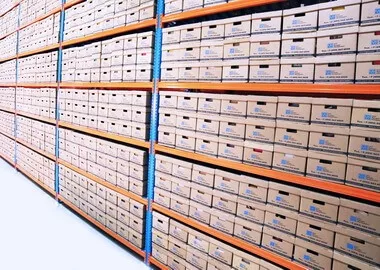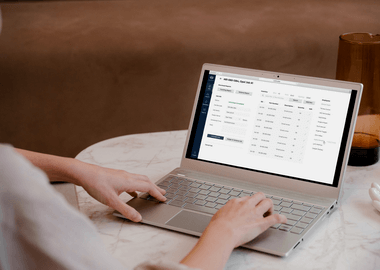Take Control of Your Operations with These 5 End-to-End Supply Chain Visibility Steps
Does “end-to-end supply chain visibility” feel like just another buzzword these days?
Everyone says it’s a must-have for retailers, suppliers, and carriers. But what does “visibility” really mean? People rarely define it clearly or explain the tangible benefits.
At Digiteum, we focus on practical solutions, not buzzwords. We don’t just talk about custom logistics software development – we show what those solutions can do.
So, let’s take a look at the actual role of end-to-end visibility and how it can bring measurable benefits.
End-to-end visibility in the supply chain is the ability to track every step of a product’s journey – from raw materials to delivery. It’s like having a live feed of what’s happening at every stage, thanks to tools like GPS, RFID, and scanners. This constant flow of real-time data gives you a clear view of your supply chain. As a result, you spot issues, streamline operations, and avoid disruptions before they become a problem.
Sounds good, but how does it look in reality? Let’s break it down with some examples.
Scenario 1.
Tom, 39, is a fleet manager who uses GPS tracking and a fleet management platform to monitor his trucks. One day, he spots a truck with high fuel usage, likely due to engine or tire issues, and quickly schedules maintenance. A quick fix gets the truck back on the road, saving fuel and avoiding bigger costs.
Scenario 2.
Sarah, 42, is a warehouse coordinator. Last week, Sarah got an alert about a delayed delivery. Instead of waiting, she checked inventory and reallocated stock to meet urgent orders. Once the shipment was back on track, she adjusted the dock schedule to keep everything running smoothly.
Scenario 3.
Malcolm, 25, handles route planning with a transportation management system (TMS). When a road closure hits, he quickly reroutes the driver and notifies the customer with automated messaging. He also assigns another driver for a nearby pickup, keeping everything on schedule.
What connects these three examples? That every-present but rarely defined visibility.
It’s what lets Tom, Sarah, and Malcolm react fast – whether it’s a truck issue, a delayed delivery, or a road closure. With visibility, they can tackle problems before they escalate.
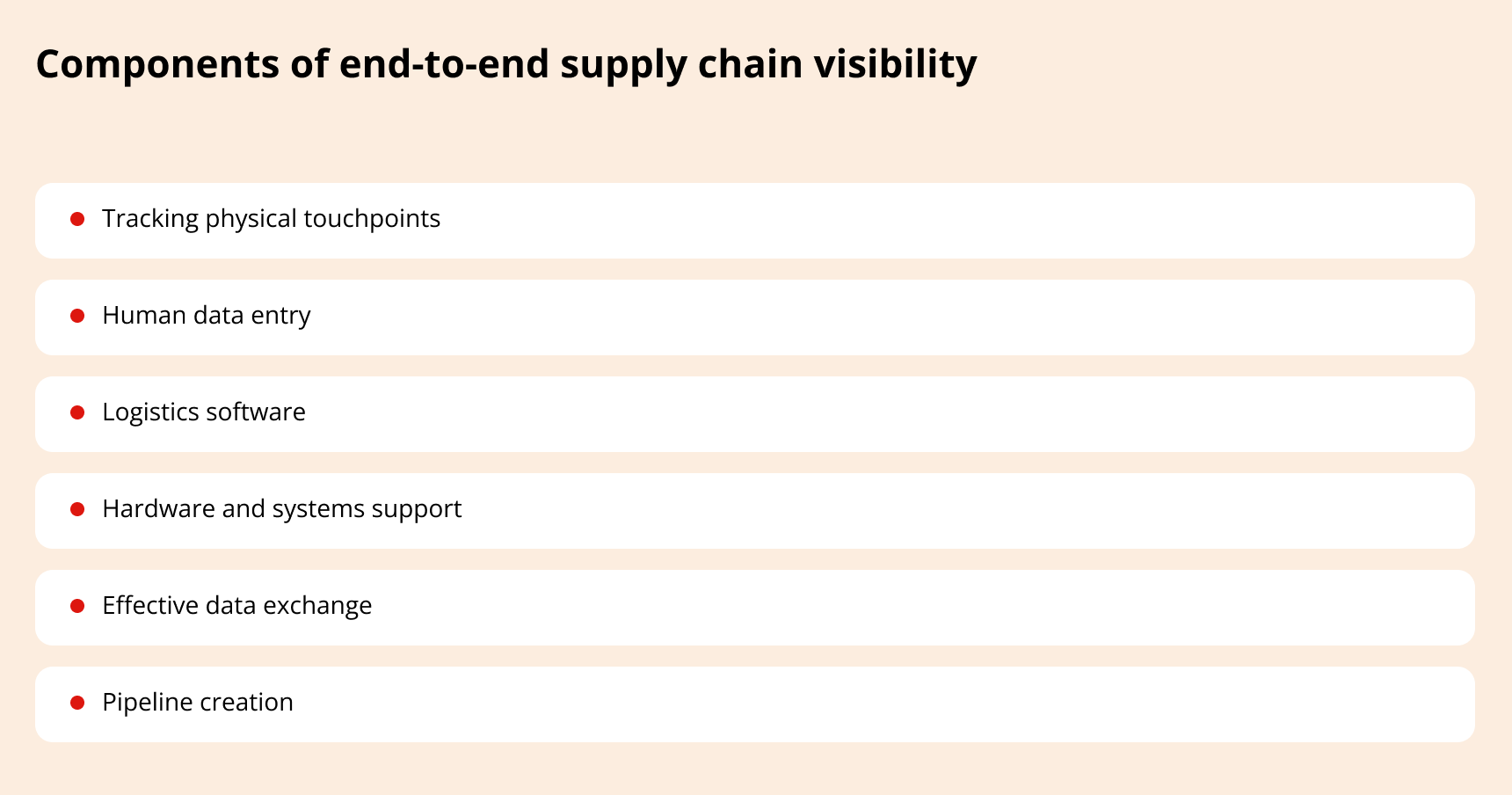
Tracking physical touchpoints
Every step in the supply chain involves physical processes. Think about packing, loading, and transporting goods. To get real visibility, you need to track each of these touchpoints accurately. If you don’t, you could lose valuable information, which can lead to delays or mistakes in deliveries.
Human data entry
Sure, while tech helps automate a lot, there’s still plenty of human input needed in the supply chain – like logging container numbers or entering data along the way. So, accurate data entry is important for visibility. Instead of counting on people to get it perfect every time, it’s smarter to give them tools that make the job easier and more accurate.
Effective data exchange
When you have data, whether it’s entered automatically or by hand, the next step is to share it between systems and stakeholders. This data exchange needs to be quick and accurate. When done right, everyone gets a real-time view of what’s happening at each stage, helping to avoid blind spots and miscommunication.
Pipeline creation
This is where true visibility comes into play – by building a pipeline that connects all touchpoints. It creates a smooth flow of information throughout the supply chain.
Logistics software
There are various types of systems out there, like ERP, WMS, TMS, and more, each focusing on specific tasks. They collect data and use it to help automate everything from planning routes to managing inventory.
Want to learn more? Digiteum has already provided a handy breakdown of the most popular types of logistics software and how they differ from one another.
Hardware and systems support
Technologies like tracking devices, RFID, scanners, and OCR can really help automate processes. Plus, centralized logistics platforms make everything easier. But here’s the catch: they need to be properly integrated to work effectively. If they aren’t, you won’t get the full benefits.
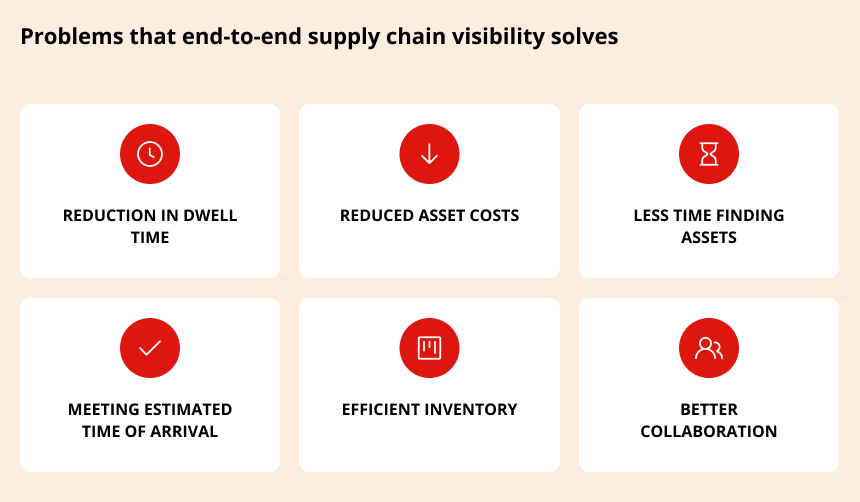
Reduction in dwell time
High dwell times slow down a supply chain. They lead to delivery delays and higher costs, which nobody wants. That’s where visibility comes in. With real-time tracking, companies can quickly spot delays and fix them. This means better teamwork between suppliers and logistics providers, making everyone more accountable for timelines.
Decrease in returnable asset costs
Lost returnable assets increase costs for companies. When items like pallets or containers go missing, they often need to be replaced, adding to the bill. Better visibility helps tackle this by letting companies track their returnable items in real-time. They can quickly locate their assets, reducing losses. This means fewer replacements and lower costs.
Less time spent finding assets
The problem is workers wasting time trying to find equipment or inventory, which slows everything down. With tools like GPS, RFID tags, and barcode scanners, real-time tracking makes it easier to find what’s needed, saving time and keeping things moving smoothly.
Fulfilling ETA (Estimated Time of Arrival)
Inaccurate delivery estimates lead to unhappy customers and potential fines for late deliveries. With improved visibility, companies can track shipments in real-time and provide more accurate ETAs. This helps keep customers informed and avoid costly delays.
Optimized inventory levels
Poor inventory management can result in overstocking or stockouts. With better visibility from inventory management systems, companies can track stock movements in real-time and keep inventory at optimal levels. This helps avoid excess stock or shortages, saving money and improving cash flow.
Improved collaboration
Stakeholders in global supply chains often work in silos with inconsistent communication, leading to delays and inefficiencies. For example, a manufacturer might halt production because they weren’t informed of a raw material delay from the supplier. With better visibility, everyone can access real-time information, making it easier to collaborate.

Step 1. Conduct an analysis
First, identify where the biggest inaccuracies are in your supply chain. Are drivers stuck with long wait times because they don’t know which gate to use? Are warehouse staff wasting time searching for items? Or maybe drivers are getting caught in traffic and can’t keep up with next-day delivery promises.
To fix these issues, start by spotting those blind spots. Review your processes and gather data to find problem areas. Consider using a centralized database to track key performance indicators and collect info from different teams.
Ask yourself: What data do I need to monitor these challenges? This will help you see where improvements are needed. Once you’ve identified the pain points, you can create a roadmap for making things better.
Step 2. Define KPIs
When setting Key Performance Indicators (KPIs) for your supply chain, it’s important to focus on current industry challenges. With a shortage of truck drivers and rising transport demand, your KPIs would most probably aim to maximize labor and vehicle capacity.
A recent study by ABI Research highlights the most common KPIs fleet managers are tracking:
- Reduced dwell time
- Improved vehicle and driver safety
- Minimized vehicle downtime
- Maximized vehicle utilization
- Reduced fleet CO2 emissions
- Improved driver productivity
- Ensured compliance
- Lower fuel costs
- On-time delivery
These insights can help you determine which KPIs to prioritize.
Step 3. Integrate real-time tracking
This is the core of supply chain visibility. With real-time tracking, users can easily keep tabs on shipments, vehicles, and assets.
To achieve this, software providers need the right technologies, including:
- GPS tracking devices in vehicles to send real-time location data
- Sensors to monitor conditions like temperature and humidity
- RFID tags and barcode scanning to track inventory and asset movement
Step 4. Integrate data across systems
So, now that you’ve got all sorts of tracking devices in place, you have a wealth of real-time data at your fingertips. But here’s the thing: having access to data isn’t the problem anymore. The real challenge is figuring out how to pull it all together and use it effectively.
Once you’ve gathered a bunch of different solutions, it’s time to get them to work together or combine them into a single platform – like a company-wide ERP system or a vendor management portal. This is the key to making the most of your data and achieving your visibility goals.
Step 5. Tailor a visibility solution to your goals
Those might be goals like building sustainable supply chains, automation, or simply keeping an eye on operations. Whatever it is, having visibility gives you an edge.
For example, a logistics company adopted strategies for warehouse optimization by setting up real-time tracking systems. This allowed them to pinpoint inventory locations quickly. As a result, they cut down on search times and sped up order fulfillment. Ultimately, better warehouse and end-to-end order visibility led to smoother operations across the entire supply chain. This made things easier for everyone involved.
Achieving end-to-end supply chain visibility is a journey
But you don’t have to go it alone. With Digiteum by your side, you’ll have a trusted partner that delivers on its promises – that’s why our clients stay with us for years.
Let’s discuss your projectHere are the top barriers named in the 2024 ABI Research study.
Better data capabilities
The top concern for 62.4% of respondents is figuring out what to do with all the data they have. Technologies for collecting data are everywhere now. What we really need are tools that can make sense of this data overload and put it to good use.
Obtaining actionable insights from tracking hardware
This barrier ties back to the previous one. Sure, hardware can track and send tons of information – like speed, location, and temperature. But when a fleet has thousands of trucks each sending this data, what’s the point if you can’t use it? Businesses don’t just need data or visibility; they need insights that lead to smart, data-driven decisions.
Availability of funding
Budgeting has always been a major hurdle for companies when planning tech investments. When it comes to investing in supply chain visibility, it can be tough to secure funding for something that sounds so vague (by the way, we hope this article will help clarify the benefits and make a stronger case for your investment).
Macroeconomic uncertainty
Macroeconomic pressures have been intense over the last four years, hitting supply chains hard in the global economy. It’s no wonder many C-level executives are cautious about investing in new technologies; they’re focused on securing short-term funds. The downside? This strategy often falls short in the mid- to long-term.
Implementing real-time visibility in manufacturing operations
Manufacturers are crucial to the supply chain, and tracking machine performance is key to preventing delays. Rollomatic, a leader in high-precision CNC machines from Switzerland, wanted to give their customers in the medical, dental, aerospace, and automotive industries better insight into their production processes.
So, Rollomatic collaborated with Digiteum to create a smart production visibility solution. We developed a mobile app and upgraded their cloud-based web application. Now, Rollomatic’s customers can easily check machine performance from any device, anytime. They get real-time updates on production progress and can quickly notify supply chain partners about any delays or issues.
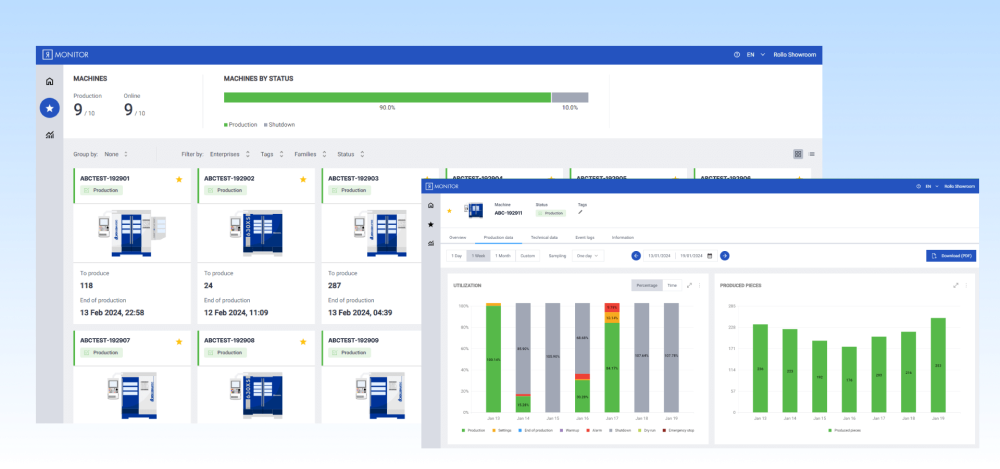
Improving supply chain visibility in maritime operations
Now, let’s talk about visibility in maritime transportation. The main challenges include poor ship performance and bad voyage planning. Without real-time tracking and data analytics, ship owners and fleet operators struggle to monitor their vessels. Just imagine a ship stuck in a storm because it couldn’t adjust its route on time – that’s the kind of risk we’re talking about.
One of Digiteum’s clients is a major maritime fleet intelligence company that helps avoid these issues. Their solution, used by industry giants like Shell and TotalEnergies, optimizes vessel performance and improves voyage planning.
In 2022, the UK branch faced a growing workload and needed to quickly expand its tech teams. They sought a reliable nearshore vendor for skilled software engineers who could adapt and scale as needed. That’s where Digiteum stepped in.
We brought in senior engineers and a dedicated Delivery Manager to ensure smooth processes. This collaboration enhanced the client’s cloud-based maritime data platform by adding a user-friendly portal and efficient data processing pipelines. As a result, they could manage their workload better and adapt to changing business needs.
Need to augment your team or build one from scratch?
We can help with both! Since 2010, we’ve been a trusted tech partner for logistics companies. Whether you want to add our expertise to your team or create a new tech squad, we're ready to help.
Let’s chatProviding end-to-end inventory visibility
Effective inventory management is key for supply chains, too. Unfortunately, traditional stocktaking methods can be a hassle, leading to inaccuracies and wasted time. And when inventory visibility is lacking, chaos can ripple through the supply chain.
Overfli, a US client specializing in warehouse automation, needed a better solution to streamline inventory management and reduce errors. Manual methods were causing delays and inaccuracies, so they turned to Digiteum for help.
We developed a user-friendly app that connects with professional scanners, allowing employees to verify stock and fill out reports instantly. It works online and offline, perfect for areas with weak Wi-Fi. With features like automatic status updates and quick error corrections, the Overfli app makes managing inventory much easier.
Now, if an employee scans an item that doesn’t match the checklist, the app prompts a rescan right away. Plus, it alerts management in real-time when stock is low, ensuring quick reordering and preventing stockouts. This solution saves costs, reduces labor time, and boosts visibility across the supply chain.
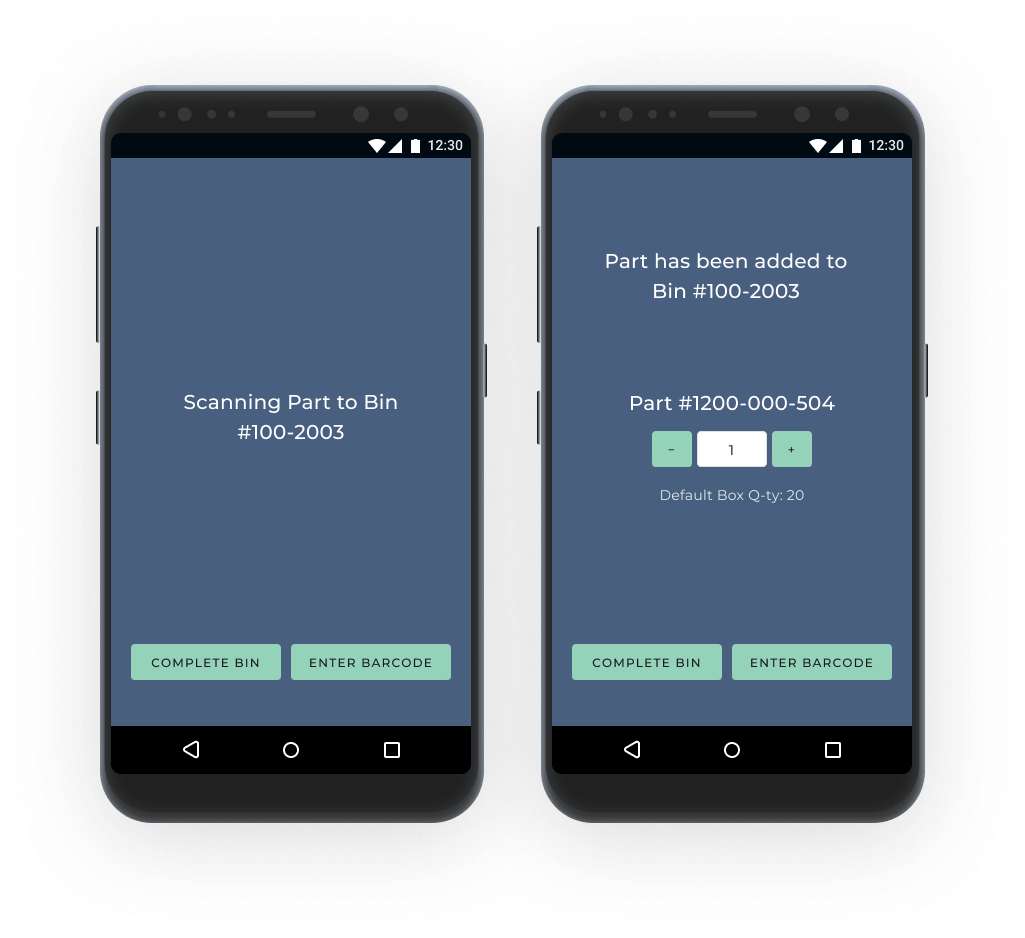
Digiteum has been working on logistics solutions since 2010, bringing high-level expertise to the table.
Here are some of our standout achievements:
- We’ve developed various logistics software. Our engineers know how to build a vendor portal, a fleet management platform, and an inventory application – just to name a few.
- We build solutions from scratch, enhance them with extra features, and ensure everything integrates smoothly with existing systems.
- But we don’t stop at software development. Our clients also get a dedicated manager who makes sure everything runs on schedule – or even better.
Partner with us!
Our team has the expertise and solid strategies to build a system that gives your business complete supply chain visibility.
Hire logistics developers




